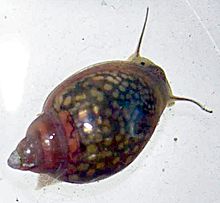Physa acuta
| Physella acuta | |
|---|---|
 |
|
| A live individual of Physella acuta | |
|
NE
|
|
| Scientific classification | |
| Kingdom: | Animalia |
| Phylum: | Mollusca |
| Class: | Gastropoda |
| (unranked): | clade Heterobranchia clade Euthyneura clade Panpulmonata clade Hygrophila |
| Superfamily: | Planorboidea |
| Family: | Physidae |
| Subfamily: | Physinae |
| Tribe: | Physellini |
| Genus: | Physella |
| Species: | P. acuta |
| Binomial name | |
|
Physella acuta (Draparnaud, 1805) |
|
| Synonyms | |
|
Physa acuta Draparnaud, 1805 |
|
Physa acuta Draparnaud, 1805
Physella heterostropha (Say, 1817)
Physella integra (Haldeman, 1841)
Physa globosa Haldeman, 1841
Haitia acuta
Physella acuta is a species of small, left-handed or sinistral, air-breathing freshwater snail, an aquatic gastropod mollusk in the family Physidae. Common names include European physa, Tadpole Snail, Bladder Snail, and Acute Bladder Snail. In addition, Phyla acuta, Physa heterostropha (Say, 1817) and Physa integra (Haldeman, 1841) are synonyms of Physella acuta (Draparnaud, 1805).
Snails in the family Physidae have shells that are sinistral, which means that if the shell is held with the aperture facing the observer and the spire pointing up, then the aperture is on the left-hand side.
The shells of Physella species have a long and large aperture, a pointed spire, and no operculum. The shells are thin and corneous and rather transparent.
It was once thought that the indigenous distribution of Physella acuta is Mediterranean. However, when Physella heterostropha is considered to be a synonym, then the indigenous distribution of the species is North American.
Physella acuta is a common species which is common in all of North America and Europe. The species seems to have first spread through the Mediterranean regions and then more slowly into Northern Europe.
This species is found in:
The distribution also includes Mediterranean regions and Africa.
The distribution includes the United States: Maryland, New Jersey, and Virginia.
This species lives in freshwater rivers, streams, lakes, ponds, and swamps.
Physella acuta is frequently found in anthropogenic reservoirs, occurring in warm water discharges from power stations and in some rivers, but very rarely and not numerously in clay pit ponds. It can survive well under temporary harsh conditions (extreme temperature and water pollution), as long as they are short-lived.
...
Wikipedia
